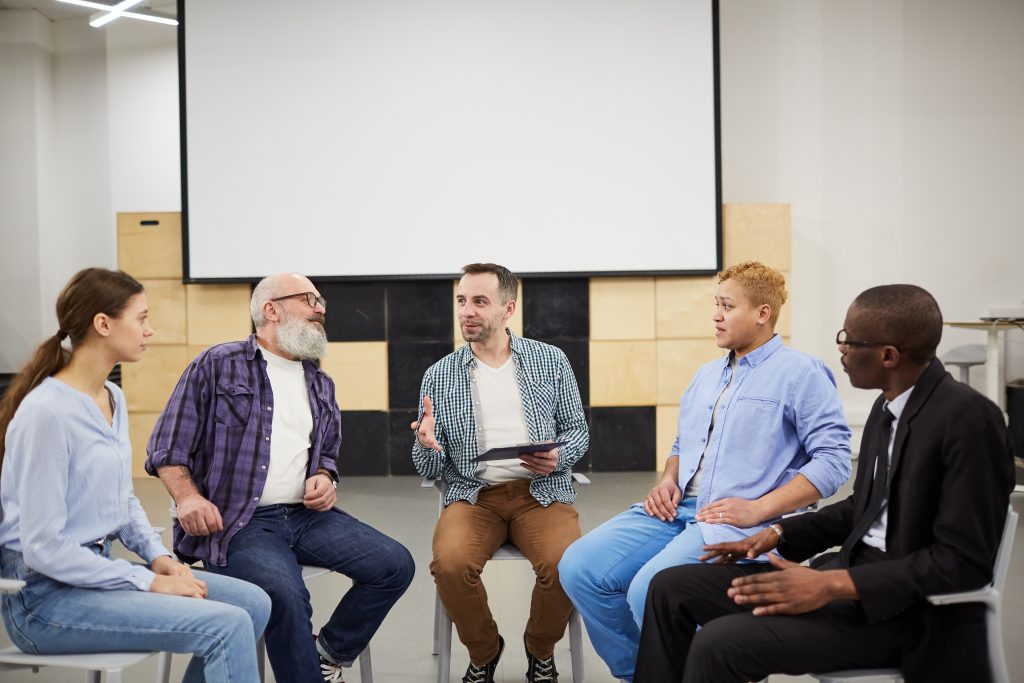
Written by Dr. Hannes Nel
The world is changing at an incredible pace.
I wonder how my late parents would have responded to the laptop computer and the internet.
I guess they would probably have refused to touch it, let alone use it.
And they were rather open-minded.
As far as I am concerned, it is the one thing that I would have loved to see develop even further.
Even though it is already hard to keep pace with what we now have.
I discuss online interviewing in this article.
Any type of interview can be conducted electronically. Electronic interviews can take place either synchronously or asynchronously. Synchronous environments include real-time chat rooms, instant messenger protocols, and real-time threaded communications. Such environments provide you and the interviewees an experience similar to face-to-face interaction insofar as they provide a mechanism for a back-and-forth exchange of questions and answers in almost real time over really long distances, actually world-wide. Computer facilities, such as Skype, ZOOM, etc. facilitate visual communication.
Asynchronous environments include the use of e-mail, forums, and privately hosted bulletin posting areas. Asynchronous environments are typically used by researchers undertaking survey-based research or a Delphi technique.
Technological developments and the growth of the internet have developed opportunities for online interviewing in qualitative research and have reduced the problems related to face-to-face interviews. The internet has altered the nature of the context in which research can take place and how knowledge is constructed by offering a different space and dimension in which conventional research designs and methods can be used and adapted.
Online interviews can be used to gather original data via the internet with the intention of analysing these to provide new evidence in relation to a specific research question. This contrasts with secondary internet research, that uses existing documents or information sources found online. Online interviews can be conducted asynchronously, i.e. in non-real-time, and synchronously, i.e. in real-time and can involve audio, textual as well as visual exchanges. Currently, emails, Facebook, bulletin boards and discussion groups, including focus groups and forums, are the most used methods of asynchronous online interviewing. Synchronous approaches focus on text-based chat groups, instant message protocols, voice-over internet protocol (VOIP) and visual conferencing to ask and answer questions and to see interview participants while conversing.
In synchronous interviews the interaction and sharing of experiences are framed by the researcher and participant(s) online presence. The real-time nature of online interviews, whether one-to-one or focus-group interviews, can encourage spontaneous interactions between participants and the researcher, whether they are involved in text-based one-to-one or group interviews or multi-channel visual interviews.
Online synchronous interviewing facilitated by online communication platforms can lead to rapid, real-time discussions. Creative use of interactive visual stimulus means they can be valuable platforms for facilitating immediate and dynamic group interactions and creating new forms of knowledge. These interactions can elevate participants’ awareness of each other and narrow the psychological distance between participants as well as enhance the feeling of joint involvement. Alternatively, you as the researcher, can set up your online forum or use an external provider to offer both synchronous text communication and a graphical representation of the environment.
An issue that can be challenging for both researchers and participants of online interviews is the fast-paced nature of online discussions, which can lead to researchers and participants lagging. The distinction between responding and ending can become blurred or responses can become brief, with the result that important data might not be shared.
Increased bandwidth and the availability of inexpensive, easy-to-use technologies have made it more viable to conduct synchronous online audio and visual interviews. Synchronous online focus groups can be set up with tools such as instant messaging and chat rooms and can offer a less threatening interview environment than visual interviews because they offer no visual clues about other participants, although you will need to make participants aware that they are taking part in a research project. You also need to establish a friendly atmosphere and to act as moderator and facilitator of the discussions. The speed and complexity of participant interactions can result in a chaotic script which can be frustrating and lead to misinterpretation of the meaning of what people said and loss of some information.
Asynchronous interviews that are conducted in non-real time are far easier to set up than synchronous interviews in terms of technological requirements. Email, for example, allows you to ask questions and receive responses as and when it suits you and the interviewee. Even so, a clear protocol in terms of the interviewing process is still needed. Also keep in mind that you will need the permission of the holders of online blogs, email addresses, etc. to use the data shared online.
Textual data collected asynchronously are in written form, therefore there is no need to transcribe. This increases the accuracy of the transcripts and reduces the potential for error. It may also enhance the interpretation of what is communicated by you as the researcher. Participants may compensate for the lack of non-verbal cues by ensuring that their descriptions portray the level of meaning and emotion that they wish to communicate, allowing a greater level of transparency and sensitivity to the original context of the data. The explicit expression of emotion in written language can be more easily interpreted and incorporated into analyses than the implicit emotional nuances offered in spoken communication.
Asynchronous data collection can be simple to administer because you only need to send your questions to the interviewees and then wait for a reply, making it a questionnaire rather than an interview. However, it can take several days or weeks for participants to reply to the questions. Further, there is a greater risk of non-response from participants than with synchronous interviews. Participants can even withdraw from the project if they regard other obligations as more important.
You may need to work hard to maintain a rapport with participants who only engage irregularly with your research project. Probes or prompts to main questions can get lost in participants’ electronic communication traffic. It is relatively easy for participants to delete messages or questions if they are too busy to respond. Spontaneity of interaction can be lost if participants digress to subjects outside the research project, making it difficult to maintain the flow of the discussion.
When conducting online interviews, you need to decide how you are going to access the target population and how you will obtain information from all the participants. When using visual conferencing with certain populations, access and availability can be greatly improved because individuals are not only connected through their home computers but also on their cell phones, tablets, reading devices or at internet cafés. For most people, this is not a problem, but older people and people with disabilities, for example, may not have access to or be able to take part in an online interview.
Whichever mode (synchronous or asynchronous interviewing) or type (one-to-one or group interview, visual or audio) you choose for your online research, you need to consider how you are going to establish a research relationship with your participants. You also need to consider the impact of the online interaction on those being researched.
In face-to-face interviews, the presentation of self is based not only on what participants choose to show, for example through gestures or tone of voice, but also on how that is perceived by others participating in social interaction. In online text-based interviews, the written word becomes the sole means of building rapport and trust. When face-to-face contact is absent, you need to keep in mind the potential obstacles that anonymity and disembodiment pose in attempting to establish a relationship of trust with other people online. When visual and social gestures and cues in online interviews are not visible, such as friendly gestures (nodding, smiling, eye contact, etc.) these have to be translated into text and you should more quickly and with greater clarity establish the profiles of the participants to determine if they can add value to your research.
Unless you are using web-cameras or visual conferencing, you and the other participants are hidden from each other. This has a detrimental effect on the discussions that will take place, although it can promote the accuracy and validity of information on sensitive topics.
Any interview situation, no matter how formalised, restricted or standardised, relies upon interaction between participants who are constantly engaged in interpretive practice. When using the internet as a communicative social space to host interaction between participants, you need to consider critically the authenticity of the data that you obtain and interpret. Online interviews or a mixture of face-to-face and online media are not less authentic or truthful than offline data. Standards of authenticity should be confirmed, even though you will need to largely rely on the trustworthiness of the participants.
Summary
Any type of interview can be conducted electronically.
Electronic interviews can take place either synchronously or asynchronously.
Technological developments and the growth of the internet have developed opportunities for online interviewing.
Synchronous approaches focus on text-based chat groups, instant message protocols, voice-over internet protocol and visual conferencing for interactive interviewing.
Currently social media are the most used for asynchronous online interviewing.
Online synchronous interviewing facilitated by online communication platforms can also lead to rapid, real-time discussions.
The fast-paced nature of online discussions can lead to researchers and participants lagging.
This can lead to the collection of superficial data.
Increased bandwidth and the availability of inexpensive, easy-to-use technologies made it more viable to conduct synchronous online audio and visual interviews.
Asynchronous interviews that are conducted non-real time are far easier to set up than synchronous interviews in terms of technological requirements.
You will need the permission of the holders of online social media platforms to use the data shared online.
Textual data collected asynchronously are in written form, therefore there is no need to transcribe the data.
Asynchronous data collection can be simple to administer.
Maintaining contact and rapport with interviewees can be challenging.
When conducting online interviews, you must decide how you are going to access the target population. You also need to decide how you will obtain information from all the participants.
Especially older people are reluctant to participate in online interviewing for a variety of reasons.
You should consider the impact of the online interaction on the interviewees.
Not being able to see participants in an online interview makes it difficult to establish trust and loyalty.
It will also be difficult to establish if the interviewee has enough relevant expertise, knowledge and experience to add value to your research project.
Online interviews or a mixture of face-to-face and online media are not less authentic or truthful than offline data.
Close
It is difficult to keep pace with the rapid development of electronics and the internet.
New interviewing opportunities are created all the time.
You can render your research much more efficient if you stay informed about new developments.
And, of course, you must use the facilities and opportunities that become available.
Enjoy your studies.
Thank you.



